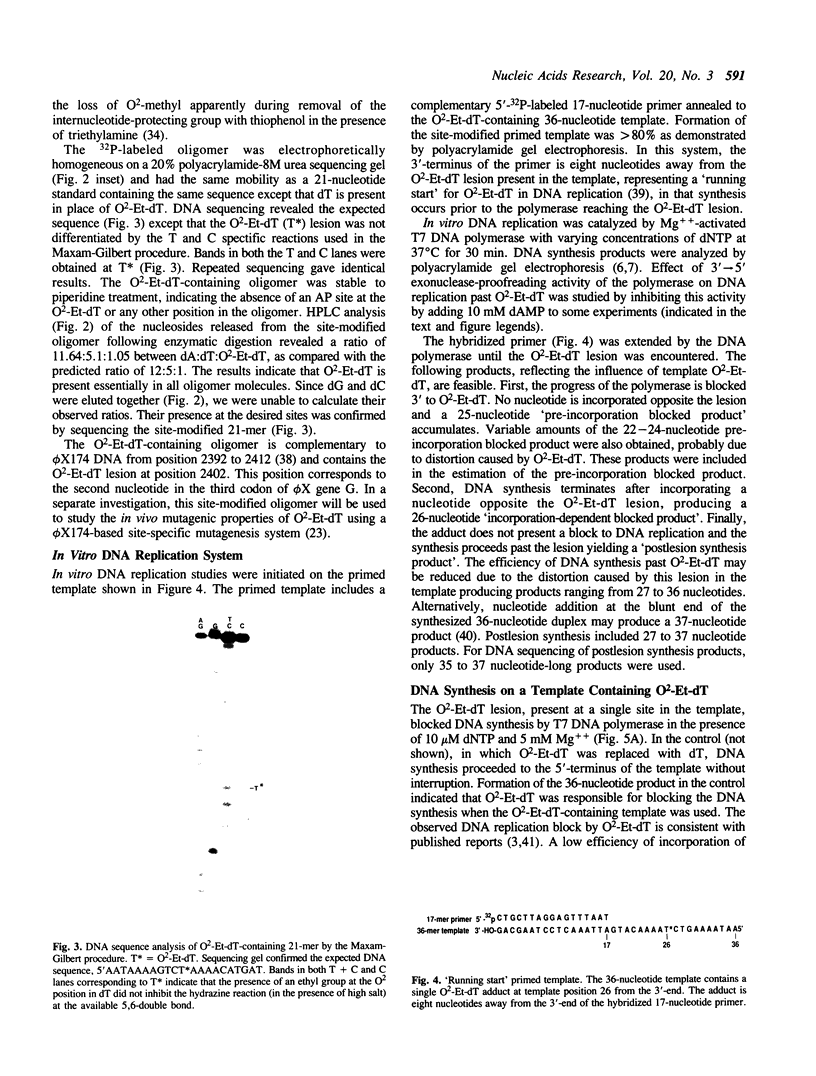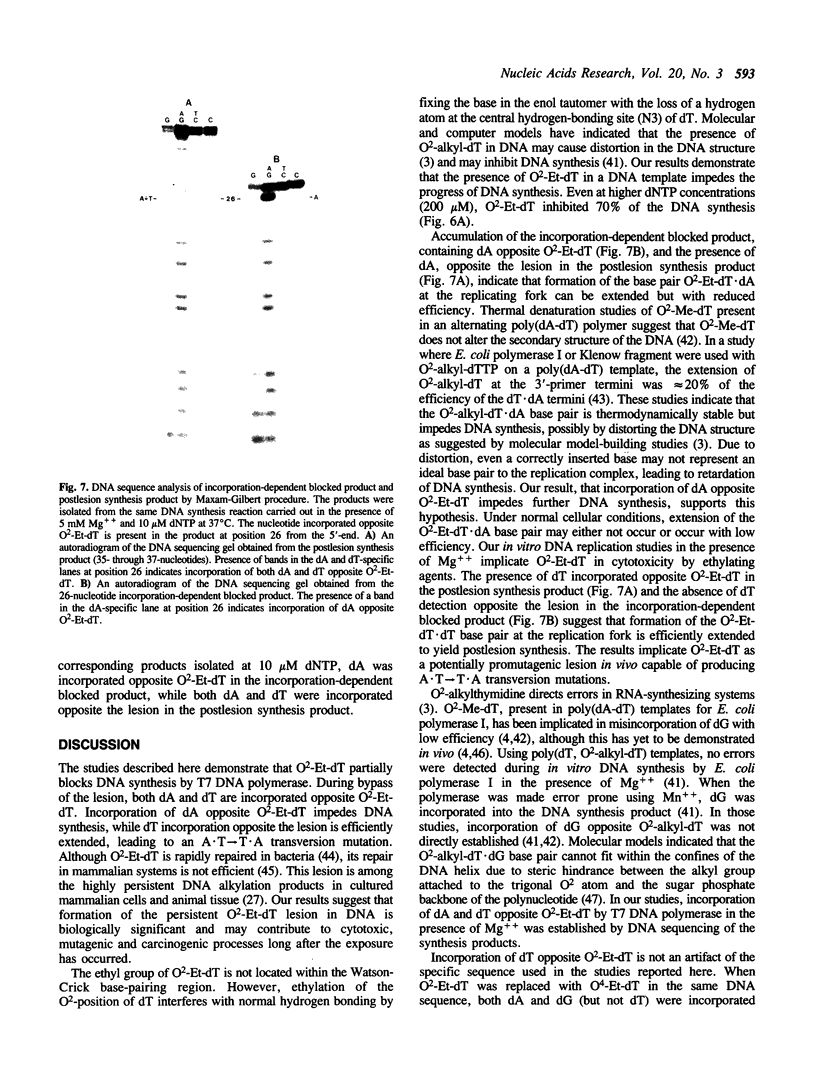Abstract
A 36-nucleotide oligomer containing a single O2-ethyldeoxythymidine (O2-Et-dT) adduct at a specific site was synthesized. The oligomer, which corresponds to a specific DNA sequence in gene G of bacteriophage phi X174, was used as a template by T7 DNA polymerase to investigate the in vitro mutagenic specificity of O2-Et-dT. At 10 microM dNTP and 5 mM Mg++, the progress of T7 DNA polymerase was interrupted by O2-Et-dT: 80% 3' to O2-Et-dT and 14% after incorporating a nucleotide opposite O2-Et-dT (incorporation-dependent blocked product). DNA synthesis past the lesion was low (6%). Incorporation of a nucleotide opposite O2-Et-dT and subsequent postlesion synthesis were enhanced by increasing the dNTP concentration, with postlesion synthesis reaching 30% at 200 microM. Postlesion synthesis was further increased to 45% by addition of 10 mM dAMP to the polymerization reactions. DNA sequencing revealed that both dA and dT were incorporated opposite O2-Et-dT with dA incorporation impeding the progress of DNA synthesis. dT incorporation was efficiently extended implicating O2-Et-dT in transversion mutagenesis in vivo. These studies provide a basis for understanding the molecular mechanisms by which ethylating agents contribute to cytotoxicity, A.T transversion mutagenesis and activation of the oncogene neu by an A.T----T.A transversion event in rat neuroblastomas.
Full text
PDF







Images in this article
Selected References
These references are in PubMed. This may not be the complete list of references from this article.
- Bargmann C. I., Hung M. C., Weinberg R. A. Multiple independent activations of the neu oncogene by a point mutation altering the transmembrane domain of p185. Cell. 1986 Jun 6;45(5):649–657. doi: 10.1016/0092-8674(86)90779-8. [DOI] [PubMed] [Google Scholar]
- Bartsch H., Montesano R. Relevance of nitrosamines to human cancer. Carcinogenesis. 1984 Nov;5(11):1381–1393. doi: 10.1093/carcin/5.11.1381. [DOI] [PubMed] [Google Scholar]
- Basu A. K., Essigmann J. M. Site-specifically modified oligodeoxynucleotides as probes for the structural and biological effects of DNA-damaging agents. Chem Res Toxicol. 1988 Jan-Feb;1(1):1–18. doi: 10.1021/tx00001a001. [DOI] [PubMed] [Google Scholar]
- Bhanot O. S., Grevatt P. C., Donahue J. M., Gabrielides C. N., Solomon J. J. Incorporation of dA opposite N3-ethylthymidine terminates in vitro DNA synthesis. Biochemistry. 1990 Nov 13;29(45):10357–10364. doi: 10.1021/bi00497a010. [DOI] [PubMed] [Google Scholar]
- Bhanot O. S., Ray A. The in vivo mutagenic frequency and specificity of O6-methylguanine in phi X174 replicative form DNA. Proc Natl Acad Sci U S A. 1986 Oct;83(19):7348–7352. doi: 10.1073/pnas.83.19.7348. [DOI] [PMC free article] [PubMed] [Google Scholar]
- Bogovski P., Bogovski S. Animal Species in which N-nitroso compounds induce cancer. Int J Cancer. 1981;27(4):471–474. doi: 10.1002/ijc.2910270408. [DOI] [PubMed] [Google Scholar]
- Borowy-Borowski H., Chambers R. W. Solid-phase synthesis and side reactions of oligonucleotides containing O-alkylthymine residues. Biochemistry. 1989 Feb 21;28(4):1471–1477. doi: 10.1021/bi00430a007. [DOI] [PubMed] [Google Scholar]
- Brent T. P., Dolan M. E., Fraenkel-Conrat H., Hall J., Karran P., Laval L., Margison G. P., Montesano R., Pegg A. E., Potter P. M. Repair of O-alkylpyrimidines in mammalian cells: a present consensus. Proc Natl Acad Sci U S A. 1988 Mar;85(6):1759–1762. doi: 10.1073/pnas.85.6.1759. [DOI] [PMC free article] [PubMed] [Google Scholar]
- Caruthers M. H. Gene synthesis machines: DNA chemistry and its uses. Science. 1985 Oct 18;230(4723):281–285. doi: 10.1126/science.3863253. [DOI] [PubMed] [Google Scholar]
- Clark J. M., Joyce C. M., Beardsley G. P. Novel blunt-end addition reactions catalyzed by DNA polymerase I of Escherichia coli. J Mol Biol. 1987 Nov 5;198(1):123–127. doi: 10.1016/0022-2836(87)90462-1. [DOI] [PubMed] [Google Scholar]
- Den Engelse L., De Graaf A., De Brij R. J., Menkveld G. J. O2- and O4-ethylthymine and the ethylphosphotriester dTp(Et)dT are highly persistent DNA modifications in slowly dividing tissues of the ethylnitrosourea-treated rat. Carcinogenesis. 1987 Jun;8(6):751–757. doi: 10.1093/carcin/8.6.751. [DOI] [PubMed] [Google Scholar]
- Dörper T., Winnacker E. L. Improvements in the phosphoramidite procedure for the synthesis of oligodeoxyribonucleotides. Nucleic Acids Res. 1983 May 11;11(9):2575–2584. doi: 10.1093/nar/11.9.2575. [DOI] [PMC free article] [PubMed] [Google Scholar]
- Eckert K. A., Ingle C. A., Drinkwater N. R. N-ethyl-N-nitrosourea induces A:T to C:G transversion mutations as well as transition mutations in SOS-induced Escherichia coli. Carcinogenesis. 1989 Dec;10(12):2261–2267. doi: 10.1093/carcin/10.12.2261. [DOI] [PubMed] [Google Scholar]
- Eckert K. A., Ingle C. A., Klinedinst D. K., Drinkwater N. R. Molecular analysis of mutations induced in human cells by N-ethyl-N-nitrosourea. Mol Carcinog. 1988;1(1):50–56. doi: 10.1002/mc.2940010111. [DOI] [PubMed] [Google Scholar]
- Grevatt P. C., Donahue J. M., Bhanot O. S. The role of N3-ethyldeoxythymidine in mutagenesis and cytotoxicity by ethylating agents. J Biol Chem. 1991 Jan 15;266(2):1269–1275. [PubMed] [Google Scholar]
- Horsfall M. J., Gordon A. J., Burns P. A., Zielenska M., van der Vliet G. M., Glickman B. W. Mutational specificity of alkylating agents and the influence of DNA repair. Environ Mol Mutagen. 1990;15(2):107–122. doi: 10.1002/em.2850150208. [DOI] [PubMed] [Google Scholar]
- Lewis S. E., Johnson F. M., Skow L. C., Popp D., Barnett L. B., Popp R. A. A mutation in the beta-globin gene detected in the progeny of a female mouse treated with ethylnitrosourea. Proc Natl Acad Sci U S A. 1985 Sep;82(17):5829–5831. doi: 10.1073/pnas.82.17.5829. [DOI] [PMC free article] [PubMed] [Google Scholar]
- Li B. F., Reese C. B., Swann P. F. Synthesis and characterization of oligodeoxynucleotides containing 4-O-methylthymine. Biochemistry. 1987 Feb 24;26(4):1086–1093. doi: 10.1021/bi00378a015. [DOI] [PubMed] [Google Scholar]
- Lindahl T., Sedgwick B., Sekiguchi M., Nakabeppu Y. Regulation and expression of the adaptive response to alkylating agents. Annu Rev Biochem. 1988;57:133–157. doi: 10.1146/annurev.bi.57.070188.001025. [DOI] [PubMed] [Google Scholar]
- Loechler E. L., Green C. L., Essigmann J. M. In vivo mutagenesis by O6-methylguanine built into a unique site in a viral genome. Proc Natl Acad Sci U S A. 1984 Oct;81(20):6271–6275. doi: 10.1073/pnas.81.20.6271. [DOI] [PMC free article] [PubMed] [Google Scholar]
- Maxam A. M., Gilbert W. Sequencing end-labeled DNA with base-specific chemical cleavages. Methods Enzymol. 1980;65(1):499–560. doi: 10.1016/s0076-6879(80)65059-9. [DOI] [PubMed] [Google Scholar]
- McCarthy T. V., Karran P., Lindahl T. Inducible repair of O-alkylated DNA pyrimidines in Escherichia coli. EMBO J. 1984 Mar;3(3):545–550. doi: 10.1002/j.1460-2075.1984.tb01844.x. [DOI] [PMC free article] [PubMed] [Google Scholar]
- Mendelman L. V., Boosalis M. S., Petruska J., Goodman M. F. Nearest neighbor influences on DNA polymerase insertion fidelity. J Biol Chem. 1989 Aug 25;264(24):14415–14423. [PubMed] [Google Scholar]
- Miller E. C. Some current perspectives on chemical carcinogenesis in humans and experimental animals: Presidential Address. Cancer Res. 1978 Jun;38(6):1479–1496. [PubMed] [Google Scholar]
- Narang S. A., Brousseau R., Hsiung H. M., Michniewicz J. J. Chemical synthesis of deoxyoligonucleotides by the modified triester method. Methods Enzymol. 1980;65(1):610–620. doi: 10.1016/s0076-6879(80)65063-0. [DOI] [PubMed] [Google Scholar]
- Perantoni A. O., Rice J. M., Reed C. D., Watatani M., Wenk M. L. Activated neu oncogene sequences in primary tumors of the peripheral nervous system induced in rats by transplacental exposure to ethylnitrosourea. Proc Natl Acad Sci U S A. 1987 Sep;84(17):6317–6321. doi: 10.1073/pnas.84.17.6317. [DOI] [PMC free article] [PubMed] [Google Scholar]
- Popp R. A., Bailiff E. G., Skow L. C., Johnson F. M., Lewis S. E. Analysis of a mouse alpha-globin gene mutation induced by ethylnitrosourea. Genetics. 1983 Sep;105(1):157–167. doi: 10.1093/genetics/105.1.157. [DOI] [PMC free article] [PubMed] [Google Scholar]
- Preston B. D., Singer B., Loeb L. A. Comparison of the relative mutagenicities of O-alkylthymines site-specifically incorporated into phi X174 DNA. J Biol Chem. 1987 Oct 5;262(28):13821–13827. [PubMed] [Google Scholar]
- Preston B. D., Singer B., Loeb L. A. Mutagenic potential of O4-methylthymine in vivo determined by an enzymatic approach to site-specific mutagenesis. Proc Natl Acad Sci U S A. 1986 Nov;83(22):8501–8505. doi: 10.1073/pnas.83.22.8501. [DOI] [PMC free article] [PubMed] [Google Scholar]
- Que B. G., Downey K. M., So A. G. Mechanisms of selective inhibition of 3' to 5' exonuclease activity of Escherichia coli DNA polymerase I by nucleoside 5'-monophosphates. Biochemistry. 1978 May 2;17(9):1603–1606. doi: 10.1021/bi00602a004. [DOI] [PubMed] [Google Scholar]
- Richardson K. K., Richardson F. C., Crosby R. M., Swenberg J. A., Skopek T. R. DNA base changes and alkylation following in vivo exposure of Escherichia coli to N-methyl-N-nitrosourea or N-ethyl-N-nitrosourea. Proc Natl Acad Sci U S A. 1987 Jan;84(2):344–348. doi: 10.1073/pnas.84.2.344. [DOI] [PMC free article] [PubMed] [Google Scholar]
- Saffhill R., Abbott P. J. Formation of O2-methylthymine in poly(dA-dT) on methylation with N-methyl-N-nitrosourea and dimethyl sulphate. Evidence that O2-methylthymine does not miscode during DNA synthesis. Nucleic Acids Res. 1978 Jun;5(6):1971–1978. doi: 10.1093/nar/5.6.1971. [DOI] [PMC free article] [PubMed] [Google Scholar]
- Saffhill R. In vitro miscoding of alkylthymines with DNA and RNA polymerases. Chem Biol Interact. 1985 Feb-Apr;53(1-2):121–130. doi: 10.1016/s0009-2797(85)80090-9. [DOI] [PubMed] [Google Scholar]
- Saffhill R., Margison G. P., O'Connor P. J. Mechanisms of carcinogenesis induced by alkylating agents. Biochim Biophys Acta. 1985 Dec 17;823(2):111–145. doi: 10.1016/0304-419x(85)90009-5. [DOI] [PubMed] [Google Scholar]
- Sanger F., Coulson A. R., Friedmann T., Air G. M., Barrell B. G., Brown N. L., Fiddes J. C., Hutchison C. A., 3rd, Slocombe P. M., Smith M. The nucleotide sequence of bacteriophage phiX174. J Mol Biol. 1978 Oct 25;125(2):225–246. doi: 10.1016/0022-2836(78)90346-7. [DOI] [PubMed] [Google Scholar]
- Shibutani S., Takeshita M., Grollman A. P. Insertion of specific bases during DNA synthesis past the oxidation-damaged base 8-oxodG. Nature. 1991 Jan 31;349(6308):431–434. doi: 10.1038/349431a0. [DOI] [PubMed] [Google Scholar]
- Singer B., Chavez F., Spengler S. J., Kuśmierek J. T., Mendelman L., Goodman M. F. Comparison of polymerase insertion and extension kinetics of a series of O2-alkyldeoxythymidine triphosphates and O4-methyldeoxythymidine triphosphate. Biochemistry. 1989 Feb 21;28(4):1478–1483. doi: 10.1021/bi00430a008. [DOI] [PubMed] [Google Scholar]
- Singer B. O-alkyl pyrimidines in mutagenesis and carcinogenesis: occurrence and significance. Cancer Res. 1986 Oct;46(10):4879–4885. [PubMed] [Google Scholar]
- Singer B., Sági J., Kuśmierek J. T. Escherichia coli polymerase I can use O2-methyldeoxythymidine or O4-methyldeoxythymidine in place of deoxythymidine in primed poly(dA-dT).poly(dA-dT) synthesis. Proc Natl Acad Sci U S A. 1983 Aug;80(16):4884–4888. doi: 10.1073/pnas.80.16.4884. [DOI] [PMC free article] [PubMed] [Google Scholar]
- Solomon J. J., Mukai F., Fedyk J., Segal A. Reactions of propylene oxide with 2'-deoxynucleosides and in vitro with calf thymus DNA. Chem Biol Interact. 1988;67(3-4):275–294. doi: 10.1016/0009-2797(88)90064-6. [DOI] [PubMed] [Google Scholar]
- Stowers S. J., Wiseman R. W., Ward J. M., Miller E. C., Miller J. A., Anderson M. W., Eva A. Detection of activated proto-oncogenes in N-nitrosodiethylamine-induced liver tumors: a comparison between B6C3F1 mice and Fischer 344 rats. Carcinogenesis. 1988 Feb;9(2):271–276. doi: 10.1093/carcin/9.2.271. [DOI] [PubMed] [Google Scholar]
- Swann P. F. Why do O6-alkylguanine and O4-alkylthymine miscode? The relationship between the structure of DNA containing O6-alkylguanine and O4-alkylthymine and the mutagenic properties of these bases. Mutat Res. 1990 Nov-Dec;233(1-2):81–94. doi: 10.1016/0027-5107(90)90153-u. [DOI] [PubMed] [Google Scholar]
- Walker G. C. Mutagenesis and inducible responses to deoxyribonucleic acid damage in Escherichia coli. Microbiol Rev. 1984 Mar;48(1):60–93. doi: 10.1128/mr.48.1.60-93.1984. [DOI] [PMC free article] [PubMed] [Google Scholar]
- Witkin E. M. Ultraviolet mutagenesis and inducible DNA repair in Escherichia coli. Bacteriol Rev. 1976 Dec;40(4):869–907. doi: 10.1128/br.40.4.869-907.1976. [DOI] [PMC free article] [PubMed] [Google Scholar]






